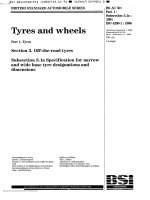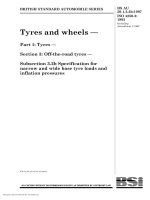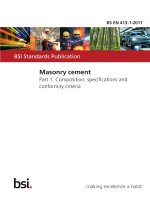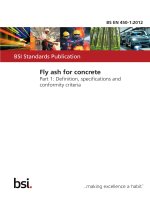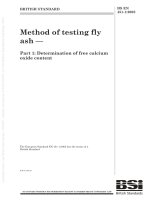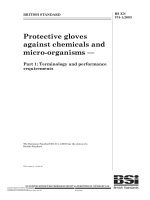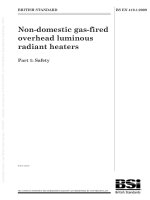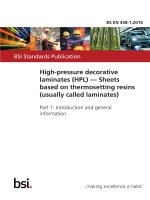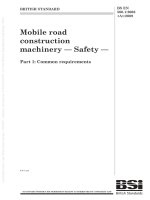Bsi bs en 62137 1 3 2009
Bạn đang xem bản rút gọn của tài liệu. Xem và tải ngay bản đầy đủ của tài liệu tại đây (2.04 MB, 28 trang )
BS EN 62137-1-3:2009
BSI British Standards
Surface mounting technology —
Environmental and endurance
test methods for surface mount
solder joint —
Part 1-3: Cyclic drop test
NO COPYING WITHOUT BSI PERMISSION EXCEPT AS PERMITTED BY COPYRIGHT LAW
raising standards worldwide™
BRITISH STANDARD
BS EN 62137-1-3:2009
National foreword
This British Standard is the UK implementation of EN 62137-1-3:2009. It is
identical to IEC 62137-1-3:2008.
The UK participation in its preparation was entrusted to Technical Committee
EPL/501, Electronic assembly technology.
A list of organizations represented on this committee can be obtained on
request to its secretary.
This publication does not purport to include all the necessary provisions of a
contract. Users are responsible for its correct application.
© BSI 2009
ISBN 978 0 580 57386 6
ICS 31.190
Compliance with a British Standard cannot confer immunity from
legal obligations.
Amendments issued since publication
Amd. No.
Date
Text affected
BS EN 62137-1-3:2009
EUROPEAN STANDARD
EN 62137-1-3
NORME EUROPÉENNE
February 2009
EUROPÄISCHE NORM
ICS 31.190
English version
Surface mounting technology Environmental and endurance test methods
for surface mount solder joint Part 1-3: Cyclic drop test
(IEC 62137-1-3:2008)
Technologie de montage en surface Méthodes d'essais d'environnement
et d'endurance des joints brasés
montés en surface Partie 1-3: Essai de chute cyclique
(CEI 62137-1-3:2008)
Oberflächenmontage-Technik Verfahren zur Prüfung
auf Umgebungseinflüsse
und zur Prüfung der Haltbarkeit
von Oberflächen-Lötverbindungen Teil 1-3: Zyklische Fallprüfung
(IEC 62137-1-3:2008)
This European Standard was approved by CENELEC on 2009-02-01. CENELEC members are bound to comply
with the CEN/CENELEC Internal Regulations which stipulate the conditions for giving this European Standard
the status of a national standard without any alteration.
Up-to-date lists and bibliographical references concerning such national standards may be obtained on
application to the Central Secretariat or to any CENELEC member.
This European Standard exists in three official versions (English, French, German). A version in any other
language made by translation under the responsibility of a CENELEC member into its own language and notified
to the Central Secretariat has the same status as the official versions.
CENELEC members are the national electrotechnical committees of Austria, Belgium, Bulgaria, Cyprus, the
Czech Republic, Denmark, Estonia, Finland, France, Germany, Greece, Hungary, Iceland, Ireland, Italy, Latvia,
Lithuania, Luxembourg, Malta, the Netherlands, Norway, Poland, Portugal, Romania, Slovakia, Slovenia, Spain,
Sweden, Switzerland and the United Kingdom.
CENELEC
European Committee for Electrotechnical Standardization
Comité Européen de Normalisation Electrotechnique
Europäisches Komitee für Elektrotechnische Normung
Central Secretariat: avenue Marnix 17, B - 1000 Brussels
© 2009 CENELEC -
All rights of exploitation in any form and by any means reserved worldwide for CENELEC members.
Ref. No. EN 62137-1-3:2009 E
BS EN 62137-1-3:2009
EN 62137-1-3:2009
-2-
Foreword
The text of document 91/802/FDIS, future edition 1 of IEC 62137-1-3, prepared by IEC TC 91, Electronics
assembly technology, was submitted to the IEC-CENELEC parallel vote and was approved by CENELEC
as EN 62137-1-3 on 2009-02-01.
The following dates were fixed:
– latest date by which the EN has to be implemented
at national level by publication of an identical
national standard or by endorsement
(dop)
2009-11-01
– latest date by which the national standards conflicting
with the EN have to be withdrawn
(dow)
2012-02-01
Annex ZA has been added by CENELEC.
__________
Endorsement notice
The text of the International Standard IEC 62137-1-3:2008 was approved by CENELEC as a European
Standard without any modification.
In the official version, for Bibliography, the following note has to be added for the standard indicated:
IEC 60068-2-27
NOTE Harmonized as EN 60068-2-27:200X1) (not modified).
IEC 60068-2-31
NOTE Harmonized as EN 60068-2-31:2008 (not modified).
__________
1)
To be ratified.
BS EN 62137-1-3:2009
-3-
EN 62137-1-3:2009
Annex ZA
(normative)
Normative references to international publications
with their corresponding European publications
The following referenced documents are indispensable for the application of this document. For dated
references, only the edition cited applies. For undated references, the latest edition of the referenced
document (including any amendments) applies.
NOTE When an international publication has been modified by common modifications, indicated by (mod), the relevant EN/HD
applies.
Publication
Year
Title
EN/HD
Year
Environmental testing Part 1: General and guidance
EN 60068-1
1994
3)
Printed board design, manufacture and
assembly - Terms and definitions
EN 60194
2006
3)
IEC 60068-1
-
2)
IEC 60194
-
2)
IEC 61188-5
Series Printed boards and printed board
EN 61188-5
assemblies - Design and use Part 5: Attachment (land/joint) considerations
IEC 61190-1-2
-
2)
Attachment materials for electronic
assembly Part 1-2: Requirements for soldering pastes
for high-quality interconnects in electronics
assembly
EN 61190-1-2
IEC 61192-1
-
2)
Workmanship requirements for soldered
electronic assemblies Part 1: General
EN 61192-1
IEC 61249-2-7
-
2)
IEC 61760-1
-
2)
2)
Undated reference.
3)
Valid edition at date of issue.
Series
2007
3)
www.bzfxw.com
2003
3)
Materials for printed boards and other
EN 61249-2-7
interconnecting structures + corr. September
Part 2-7: Reinforced base materials, clad and
unclad - Epoxide woven E-glass laminated
sheet of defined flammability (vertical burning
test), copper-clad
2002
2005
3)
Surface mounting technology EN 61760-1
Part 1: Standard method for the specification
of surface mounting components (SMDs)
2006
3)
BS EN 62137-1-3:2009
–2–
62137-1-3 © IEC:2008
CONTENTS
1
Scope ...............................................................................................................................5
2
Normative references .......................................................................................................5
3
Terms and definitions .......................................................................................................5
4
General remarks...............................................................................................................6
5
Test equipment and materials...........................................................................................7
6
5.1 Reflow soldering oven .............................................................................................7
5.2 Drop impact test equipment .....................................................................................7
5.3 Test substrate .........................................................................................................7
5.4 Solder alloy .............................................................................................................7
5.5 Solder paste ............................................................................................................7
5.6 Specimen components ............................................................................................7
5.7 Strain gauge............................................................................................................8
Mounting method ..............................................................................................................8
7
Test method and procedure, and judgment conditions ......................................................8
8
7.1 Test procedure ........................................................................................................8
7.2 Judgment conditions ...............................................................................................9
Items to be included in the test report ...............................................................................9
9
Items to be given in the product specification ...................................................................9
www.bzfxw.com
Annex A (normative) Drop impact test equipment................................................................. 11
Annex B (normative) Test method and procedure................................................................. 13
Annex C (informative) An example of test equipment and procedure .................................... 16
Annex D (informative) An example of strain gauge attachment procedure ............................ 18
Bibliography.......................................................................................................................... 23
Figure 1 – Area for evaluation in the cyclic drop test ...............................................................6
Figure 2 – Typical reflow soldering profile ...............................................................................8
Figure A.1 – Conceptual illustration of a substrate securing jig (reference) ........................... 12
Figure B.1 – Strain gauge attachment example and guide mark ............................................ 13
Figure B.2 – Strain and other waveforms (example) .............................................................. 14
Figure B.3 – Examples of crack (fracture) modes .................................................................. 14
Figure B.4 – Correlation between the number of failures and the maximum strain ................. 15
Figure C.1 – Example of drop impact test equipment and connections for testing ................. 16
Figure D.1 – Items to use...................................................................................................... 19
Figure D.2 – Strain gauge attachment procedures ................................................................ 21
Figure D.3 – Gauge factor compensation .............................................................................. 21
Figure D.4 – Example of attaching strain gauge and guide mark dimensions ........................ 22
BS EN 62137-1-3:2009
62137-1-3 © IEC:2008
–5–
SURFACE MOUNTING TECHNOLOGY –
ENVIRONMENTAL AND ENDURANCE TEST METHODS
FOR SURFACE MOUNT SOLDER JOINT –
Part 1-3: Cyclic drop test
1
Scope
The test method described in this part of IEC 62137 applies to solder joints between terminals
of surface mounting devices (SMDs) and land patterns on printed wiring boards (PWBs).
This test is intended to evaluate the strength of the solder joints of larger sized multi-terminal
components and other components in devices (e.g. handheld mobile devices) in the event
that the device is dropped. The properties of the solder joints (e.g. solder alloy, substrate,
mounted device or design, etc.) are evaluated to assist in improving the strength of the solder
joints.
2
Normative references
The following referenced documents are indispensable for the application of this document.
For dated references, only the edition cited applies. For undated references, the latest edition
of the referenced document (including any amendments) applies.
www.bzfxw.com
IEC 60068-1, Environmental testing – Part 1: General and guidance
IEC 60194, Printed boards design, manufacture and assembly – Terms and definitions
IEC 61249-2-7, Materials for printed boards and other interconnecting structures – Part 2-7:
Reinforced base materials clad and unclad – Epoxide woven E-glass laminated sheet of
defined flammability (vertical burning test), copper-clad
IEC 61188-5 (all parts 5), Printed boards and printed board assemblies – Design and use –
Part 5: Attachment (land-joint) considerations
IEC 61190-1-2, Attachment materials for electronic assembly – Part 1-2: Requirements for
soldering pastes for high-quality interconnects in electronics assembly
IEC 61192-1, Workmanship requirements for soldered electronic assemblies – Part 1: General
IEC 61760-1, Surface mounting technology – Part 1: Standard method for the specification of
surface mounting components (SMDs)
3
Terms and definitions
For the purposes of this document, the terms and definitions given in IEC 60068-1 and
IEC 60194, as well as the following definitions, apply.
3.1
drop impact strength
strength of the test substrate held by a jig that is dropped from a specified height, as
represented by the number of cyclic drops that finally cause fracture at the intermetallic, the
BS EN 62137-1-3:2009
62137-1-3 © IEC:2008
–6–
surface plating, or within the joint between a surface mounting device (SMD) termination and
a printed wiring board (PWB) copper land termination
3.2
strain
substrate surface strain
value indication measured by the strain gauge attached to the surface of the test substrate
NOTE It is a numeric dimensionless quantity representing the degree of stretching observed when the test
substrate is distorted.
3.3
maximum strain
maximum strain in the tensile side (+) on the measured strain waveform
3.4
momentary interruption detector
device that detects extremely short electrical discontinuity (momentary interruptions) in a
daisy-chain circuit
4
General remarks
The mechanical properties of the joint between a terminal to a land on a printed wiring board
using lead-free solder are not the same for the joint using tin-lead solder due to the difference
in composing elements of the solders. Thus it becomes important to test the mechanical
properties of solder joints using different solder alloys.
www.bzfxw.com
This test is to evaluate the durability of joints that are formed by reflow soldering between
SMD pins/electrodes and substrate lands in relation to drop heights. To evaluate the drop
impact that the specimen joint receives, the strain can be used as an indicator of the impact,
and it can quantitatively be measured using a strain gauge.
NOTE This drop impact test is not intended to be targeted at components themselves. Refer to IEC 60068-2-27
and IEC 60068-2-31 for test methods of the components.
Figure 1 is a conceptual illustration of the joint strength evaluation area of this test.
SMD component
Plated layers
Evaluation area
Solder
Substrate
Intermetallic compound
layers
Substrate land
IEC
Figure 1 – Area for evaluation in the cyclic drop test
2095/08
BS EN 62137-1-3:2009
62137-1-3 © IEC:2008
5
5.1
–7–
Test equipment and materials
Reflow soldering oven
Unless otherwise specified, the reflow soldering oven shall be able to realize the temperature
profile given in Figure 2.
5.2
Drop impact test equipment
This test equipment shall consist of a tester with a substrate securing jig and a measuring
instrument. Unless otherwise specified, the following specifications apply.
a) Tester: Use a tester that fulfills the requirements specified in Clause A.2.
b) Substrate securing jig: Use a substrate securing jig that fulfills the requirements specified
in A.2.2.
c) Measuring instrument: Use a measurement instrument that fulfills the requirements
specified in A.2.3.
5.3
Test substrate
Unless otherwise prescribed by the relevant specification, the test shall be conducted on a
specimen (device) mounted by its normal means on the following substrate:
a) Material: The substrate shall be a general double-sided board that is, as specified in
IEC 61249-2-7.
b) Thickness: The substrate thickness shall be either 1,0 mm or as specified in
IEC 61249-2-7.
www.bzfxw.com
c) Size: The substrate shall be of a size that allows testing using the jig specified in 5.2 b).
NOTE Since the substrate is supported at its margins, there should not be lands (e.g., check lands) at the
margins of the substrate.
d) Land geometry: The shape and size of a land shall comply with the IEC 61188-5 series or
as specified by the component manufacturer.
e) Surface protection: The solderable areas of the substrate (lands) shall be protected
against oxidization by suitable means, e.g. by an organic or inorganic surface protection
layer. This protective layer shall not adversely have an effect on the solderability of the
lands under the soldering conditions described in Clause 6.
5.4
Solder alloy
Unless otherwise specified, the solder used in this test shall be Sn96,5Ag,30Cu0,5.
5.5
Solder paste
Unless otherwise specified, the solder paste used in this test shall comply with IEC 61190-1-2.
The solder alloy specified in 5.4 shall be used for the solder paste.
5.6
Specimen components
Unless otherwise specified, specimen components shall be of a structure that allows
continuity to be checked (e.g., daisy chain). They shall be designed based on the same
specifications as the actually used components. The solder joints should be checked, as
specified in IEC 61192-1, and the pattern design should be in accordance with the IEC 611885 series.
When using daisy-chain connections, care shall be taken not to cause any break in wiring
patterns on the substrate. For example, the wiring patterns should be drawn not in the
longitudinal direction on the test substrate, but in the crosswise direction.
BS EN 62137-1-3:2009
62137-1-3 © IEC:2008
–8–
5.7
Strain gauge
Unless otherwise specified, the following specifications apply:
a) The gauge length shall be 1 mm.
b) The strain gauge shall be a foil-type gauge.
c) The strain gauge shall be of a single-axis type.
6
Mounting method
The following steps shall be taken:
a) Apply the solder paste specified in 5.5 to the lands of a test substrate as specified in 5.3,
using a metal mask with openings of the same size, shape and configuration as the lands
on the substrate, made of stainless steel with a thickness of 100 μm to 150 μm.
b) Mount the test specimen on the test substrate with solder paste applied.
c) Use the reflow-soldering oven specified in 5.1 to solder the terminals under the conditions
given below. Typical temperature profile of reflow soldering is given in Figure 2 as
proposed in IEC 61760-1. The temperature is measured at the land.
300
SnAgCu Reflow
250 °C
245 °C
235 °C
220 °C
Temperature °C
250
www.bzfxw.com
200
180 °C
Preheating
ca 45 s … 90 s > 220 °C
150 °C
150
Typical
Ramp down rate < 6 k/s
100
Ramp up rate < 3 k/s
50
0
0
30
60
90
120
150
180
210
Time s
240
270
300
330
360
Continous line: typical process (terminal temperature)
Dotted line: process limits. Bottom process limit (terminal temperature). Upper process limit (top surface
temperature)
IEC 1176/07
Figure 2 – Typical reflow soldering profile
7
7.1
Test method and procedure and judgment conditions
Test procedure
Unless otherwise specified, the following test procedure applies:
a) Attach the strain gauge to the test substrate on the surface where the specimen
component is mounted, i.e. close to the component. When attaching the strain gauge, use
the procedure specified by the gauge manufacturer.
BS EN 62137-1-3:2009
62137-1-3 © IEC:2008
–9–
b) Mount the test substrate on the substrate securing jig.
c) Drop the substrate securing jig holding the test substrate from the height specified in
Clause B.2 c) and then read the strain that results from the drop.
d) After the preliminary test (steps a) to c) above) for strain measurement is complete,
cyclically drop the substrate securing jig on which the test substrate is mounted from the
specified height.
e) Obtain the number of drops that finally cause a discontinuity.
f)
7.2
When necessary, analyse the condition at the fracture location to identify the failure mode.
(see Clause B.2 f) .
Judgment conditions
When a momentary interruption in electrical continuity is found in the specimen, it shall be
judged as a failure.
NOTE There are two methods of failure judgment. One method is to continuously monitor the daisy-chain signal
line using a strain measurement instrument to judge occurrence of a momentary interruption. The other method is
to use a momentary interruption detector or other instrument for judgment.
8
Items to be included in the test report
The following items shall be included:
a) Date
b) Name of the test organization
www.bzfxw.com
c) Name of the electronic component, type, size, dimensions
d) Material of the component terminals, and layer structure, if applicable
e) Material of the test substrate, size, structure of layers, type of protective layers
f)
Geometry of substrate lands and layer structure, if applicable
g) Types of solder alloy and solder paste used
h) Temperature profile of reflow soldering and the atmosphere (oxygen content, if soldered in
nitrogen atmosphere)
i)
Drop impact test equipment (tester specifications, substrate securing jig dimensions and
material and measurement instrument specifications), test condition (temperature, RH,
sample aging, etc)
j)
Graph representing the relationship between the drop height and the number of fractures
k) Graph representing the relationship between the strain and the number of fractures
l)
Number of drops
m) Fracture mode (photograph, etc.)
n) Strain gauge model
o) Strain gauge attachment position
9
Items to be given in the product specification
The following items shall be included:
a) Reflow soldering oven (5.1)
b) Drop impact test equipment (5.2)
c) Test substrate (5.3)
d) Solder alloy (5.4)
e) Solder paste (5.5)
BS EN 62137-1-3:2009
– 10 –
f)
62137-1-3 © IEC:2008
Specimen components (5.6)
g) Strain gauge (5.7)
h) Mounting method (Clause 6)
i)
Test method and procedure and judgment conditions (Clause 7)
www.bzfxw.com
BS EN 62137-1-3:2009
62137-1-3 © IEC:2008
– 11 –
Annex A
(normative)
Drop impact test equipment
A.1
Object
Annex A applies to the drop impact test equipment specified in 5.2 and provides details of the
equipment.
A.2
Drop impact test equipment
A.2.1
Tester
The tester is an equipment equipped with a mechanism that can drop a substrate securing jig
having a protrusion at its base, from a certain height onto a collision plane to apply impact
that would result from a free fall or similar situation. The tester shall fulfill the requirements
listed below (see also Clause C.2):
a) The tester mechanism shall use a substrate securing jig.
b) The tester mechanism shall be capable of measuring the strain on the substrate surface
caused by drop impact.
c) The tester mechanism shall be capable of checking the specimen's electrical continuity
during the test.
www.bzfxw.com
d) The tester mechanism shall be capable of holding the substrate securing jig in a stable
attitude to ensure that the protrusion will collide against the plane when the jig reaches the
plane.
e) The collision plane shall be a steel plate. However, this is not mandatory if appropriate
strain repeatability can be obtained.
NOTE
A.2.2
The collision plane should be firmly fixed to ensure that it does not move.
Substrate securing jig
The substrate securing jig shall carry a protrusion at its base. The test substrate shall be fixed
by bolts. The substrate securing jig is directly dropped onto the collision plane in order to
apply drop impact to the solder joints. The substrate securing jig shall fulfill the following
requirements:
NOTE 1
Figure A.1 is a conceptual illustration of the substrate securing jig.
a) Shape of the colliding part: The colliding part shall be an SR14 protrusion. However, this
is not mandatory if appropriate strain repeatability can be obtained.
b) Material of the colliding part: The colliding part shall be made of steel.
NOTE 2
used.
Because the colliding part will be distorted by repeated collisions, a quenched steel plate should be
c) Jig shape (thickness): The jig thickness shall be 15 mm. However, this is not mandatory if
appropriate strain repeatability can be obtained.
d) Distance between supporting points: This shall measure 80 mm. However, this is not
mandatory if the reliability of results can be ensured.
e) Test substrate securing method: The substrate shall be secured with bolts. The substrate
shall be fixed directly or indirectly using a plate.
f)
Jig material: This shall be in aluminum alloy. However, this is not mandatory if appropriate
strain repeatability can be obtained.
BS EN 62137-1-3:2009
– 12 –
62137-1-3 © IEC:2008
Screw
Substrate
Component
Colliding part
Collision plane
IEC
2096/08
Figure A.1 – Conceptual illustration of a substrate securing jig (reference)
A.2.3
Measurement instruments
The strain measurement instrument and momentary interruption detector shall fulfill the
following requirements:
a) Strain measurement instrument: The strain measurement instrument is a device that is
used to measure the strain during drop impact tests and to detect electrical discontinuity
(momentary interruption) in the daisy-chain circuit. An instrument with a 200 kHz or higher
sampling rate shall be used. However, a sampling rate lower than 200 kHz is allowed if the
reliability of measurement results can be ensured.
www.bzfxw.com
b) Momentary interruption detector: A momentary interruption detector shall be used when
momentary interruptions have to be detected using a means other than the measurement
instrument specified in A.2.3 a).
NOTE The resolution of the momentary interruption detector should be such that 100 μs momentary
interruptions can be detected.
BS EN 62137-1-3:2009
62137-1-3 © IEC:2008
– 13 –
Annex B
(normative)
Test method and procedure
B.1
Object
Annex B applies to Clause 7 and specifies details of the procedure.
B.2
Test method
The test methods and procedures are given below:
a) Strain gauge attachment: Attach the strain gauge to the test substrate. The gauge shall be
attached to the surface on which the specimen component is mounted, at a location in the
vicinity of the component. The gauge shall be oriented in parallel to the test specimen.
NOTE 1 The position of attachment should be controllable and clearly indicated. Figure B.1 shows an
example with a guide mark provided (see Clause D.4.)
www.bzfxw.com
Guide mark
IEC
2097/08
Figure B.1 – Strain gauge attachment example and guide mark
b) Test substrate attachment: The test substrate shall be attached to the substrate securing
jig with its component side facing downward.
c) Test level (height): Two test levels (heights), 1,5 m and 0,75 m, shall be used for tests.
However, if these two levels are inappropriate for a particular specimen, two different
levels can be used for tests.
d) Strain measurement (preliminary test): Strain measurement shall be conducted to read the
strain that, measured from the attachment position specified in 7.1 a) of this standard,
results from the drop from each test level (height). On the obtained strain waveform, the
peak tensile strain (on the + side) shall be considered as the maximum strain.
When various types of specimens are used, the strain shall be measured for each type of
specimen. If the specimens are of the same type, only one arbitrary specimen shall be
measured.
Strain measurement shall be conducted for different purposes, including checking the
compatibility between different testers in terms of response to a given drop impact and
checking the repeatability of a drop impact that the testers can apply.
BS EN 62137-1-3:2009
62137-1-3 © IEC:2008
– 14 –
NOTE 2 The figure below provides an example of an obtained strain waveform. This example shows results of
monitoring both the strain waveform obtained on the strain measurement instrument and the voltage measured on
the daisy-chain circuit signal line at the same time.
Daisy-chain signal line
+ Strain (tensile)
Momentary interruption occurred (voltage drop)
Strain waveform
0 με
– Strain (compressive)
20 ms/div
IEC
2098/08
Figure B.2 – Strain and other waveforms (example)
e) Drop test: After the preliminary test (step d) above) involving strain measurement is
complete, attach the specimen to the substrate securing jig and cyclically drop it from
each test level (height) to obtain the number of drops that finally causes an electrical
discontinuity (momentary interruption).
f)
www.bzfxw.com
Analysis at fracture location: When necessary, the condition at the location of the fracture
shall be analysed.
NOTE 3 Figure B.3 provides examples of three fracture modes. This analysis can identify the location at
which the specimen was broken (i.e. where it is weak).
Solder crack
Broken pattern on substrate
Crack on interposer
substrate through hole
IEC
2099/08
Figure B.3 – Examples of crack (fracture) modes
NOTE 4 To achieve the first failure, there is interdependence between the number of drops and the
maximum strain. As the maximum strain increases, the required number of drops decreases (see Figure.B.4).
BS EN 62137-1-3:2009
62137-1-3 © IEC:2008
– 15 –
■ Strain by drop test
Maximum strain (με)
The arbitrary maximum strain
The number of drops of presumed failure
IEC
2100/08
Figure B.4 – Correlation between the number of failures and the maximum strain
NOTE 5
As an alternative to creating strain, the method of dropping a test rod or ball can be used.
www.bzfxw.com
BS EN 62137-1-3:2009
62137-1-3 © IEC:2008
– 16 –
Annex C
(informative)
Example of test equipment and procedure
C.1
Object
Annex C provides examples of a tester and a test embodiment.
C.2
Tester example
The tester example shown in Figure C.1 includes an arm from which the substrate securing jig
is suspended. The arm drops along two shafts and collides with the collision plane provided at
a lower level. The strain measurement instrument consists of an oscilloscope and a strain
amplifier. If a momentary interruption occurs in the daisy-chain circuit, it is detected by a
momentary interruption detector.
Daisy chain
Momentary
interruption
detector
www.bzfxw.com
Bridge circuit
Arm
Suspension string
SMD
Strain amplifier
Board securing jig
Strain gauge
Test substrate
Collision plane
IEC
Figure C.1a – Tester
Oscilloscope
2101/08
IEC
2102/08
Figure C.1b – Example of connections
Figure C.1 – Example of drop impact test equipment and connections for testing
C.3
Test embodiment
This clause provides a test embodiment that includes the test equipment described in the list
below:
a) Attach the strain gauge near the component on the test substrate, and then connect it to
the strain measurement instrument.
b) Measure the strain at each test level (preliminary test).
BS EN 62137-1-3:2009
62137-1-3 © IEC:2008
– 17 –
c) Solder the leads to the continuity monitoring terminal (daisy-chained) on the test substrate,
and then connect it to the momentary interruption detector.
d) Screw the test substrate to the substrate securing jig, and then attach the substrate
securing jig to the arm of the test equipment.
e) Set the arm at the specified height, and then temporarily make it quiescent.
f)
Check that nothing is on the collision plane, and then press the switch to drop the
specimen.
g) After the specimen drops, catch the rebounded jig by hand.
h) At this point, check the momentary interruption indicator on the momentary interruption
detector. If the indicator does not light, repeat steps e) to g).
i)
If the momentary interruption indicator on the momentary interruption detector lights, press
the component by hand to check that the indicator lights again.
j)
The number of drops tried so far shall be considered as the number of drops required to
cause fracture.
k) If the momentary interruption indicator does not light when the component is pressed by
hand, repeat steps e) to g).
NOTE 1 The strain is not stable immediately after a steel plate is newly installed as the collision plane. Therefore,
the jig without a test substrate should be dropped on the collision plane about five times before actual strain
measurement.
NOTE 2 The following items should be checked each time this test is conducted: The substrate setscrew status,
the colliding part installation status (if the colliding part is installed with screws), the status of the steel plate used
as the collision plane, and connections to the momentary interruption detector.
www.bzfxw.com
BS EN 62137-1-3:2009
– 18 –
62137-1-3 © IEC:2008
Annex D
(informative)
Example of strain gauge attachment procedure
D.1
Object
Annex D provides examples of a strain gauge attachment procedure. The objective of this
procedure is to correctly measure the value of the strain of the evaluation sample that is
generated when the sample receives drop impact.
D.2
Items to use
The items to use for strain gauge attachment are shown in Figure D.1. For this purpose, the
dedicated adhesive indicated below must be used to attach a strain gauge. When another
type of adhesive is used, separate evaluation work is required. This manual is applicable only
to the drop impact resistance reliability test.
www.bzfxw.com
BS EN 62137-1-3:2009
62137-1-3 © IEC:2008
– 19 –
Strain gauge
(Polyimide carrier foil gauge)
Adhesive dedicated to the strain gauge
(cyanoacrylate type )
Cellulose pads
Ethanol
www.bzfxw.com
Cellophane tape
Test substrate
IEC 2103/08
Figure D.1 – Items to use
D.3
Strain gauge attachment procedure
The strain gauge attachment procedure is described below in Figures D.2a and D.2b.
BS EN 62137-1-3:2009
– 20 –
62137-1-3 © IEC:2008
Step 1: dividing the substrate
By using a router, divide the substrate without applying stress
to the substrate
Step 2: cleaning the board surface
By using the wiper (cellulose pads) moistened with ethanol, clean
the location where a strain gauge is to be attached
(on the mount side).
WARNING
At this time, make sure that no stress is applied to the location
Step 3: attachment using cellophane tape 1
www.bzfxw.com
Attach a strain gauge to cellophane tape, then position and attach
the strain gauge onto the substrate temporarily.
WARNING
Don’t use too sticky tapes
Step 4: attachment using cellophane tape 2
Tear off the strain gauge together with cellophane tape until the back
of the strain gauge is visible
IEC 2104/08
Figure D.2a – Strain gauge attachment procedure (1)
BS EN 62137-1-3:2009
62137-1-3 © IEC:2008
– 21 –
Step 5: attaching the strain gauge 1
Apply a drop of the adhesive dedicated to the strain gauge onto
the back of the strain gauge
Step 6: attaching the strain gauge 2
When attaching the strain gauge, squeeze the adhesive between
the gauge and the substrate with the index finger, then still holding it,
nip the tape and the substrate for 10 s or more.
WARNING
Make sure that no adhesive flows onto the component package
Step 7: hardening of adhesive
www.bzfxw.com
When one minute or more has elapsed, tear off the cellophane tape
slowly. Then, leave the substrate at room temperature for one hour or
more for the adhesive to harden completely.
WARNING
Be careful to not damage the connection of the lead wire to the gauge
IEC 2105/08
Figure D.2b – Strain gauge attachment procedure (2)
Figure D.2 – Strain gauge attachment procedures
Each strain gauge has its specific gauge factor. A true strain value can be obtained by
compensating the reading with the gauge factor. Usually, a strain value can be compensated
by entering the gauge factor into the measuring instrument.
The following is the compensation expression:
True strain value =
2,00
Gauge factor of
the strain gage
× Reading
IEC 2106/08
Figure D.3 – Gauge factor compensation
BS EN 62137-1-3:2009
62137-1-3 © IEC:2008
– 22 –
D.4
Strain gauge guide marks
Attach a strain gauge on the side on which the component under test is mounted. The position
at which it is attached shall be 3,25 mm apart from the centre of a land at a package corner.
To ensure attachment position precision, it is recommended that strain gauge guide marks be
placed. Figure D.4 below shows an example of attaching the strain gauge. For reference, the
dimensions of the guide marks are given.
3 guide marks
2,00 mm
1,80 mm
3,25 mm
3 gauge centre marks
0,70 mm
0,75 mm
IEC 2107/08
Figure D.4 – Example of attaching strain gauge and guide mark dimensions
www.bzfxw.com
BS EN 62137-1-3:2009
62137-1-3 © IEC:2008
– 23 –
Bibliography
IEC 60068-2-27, Environmental testing – Part 2-27: Tests – Test Ea and guidance: Shock
IEC 60068-2-31, Environmental testing – Part 2-31: Tests – Test Ec: Rough handling shocks,
primarily for equipment-type specimens
___________
www.bzfxw.com
